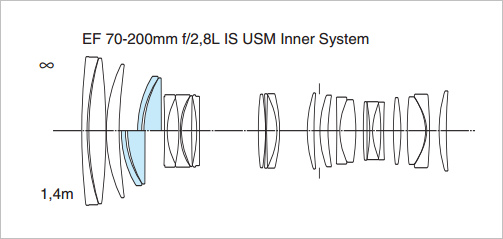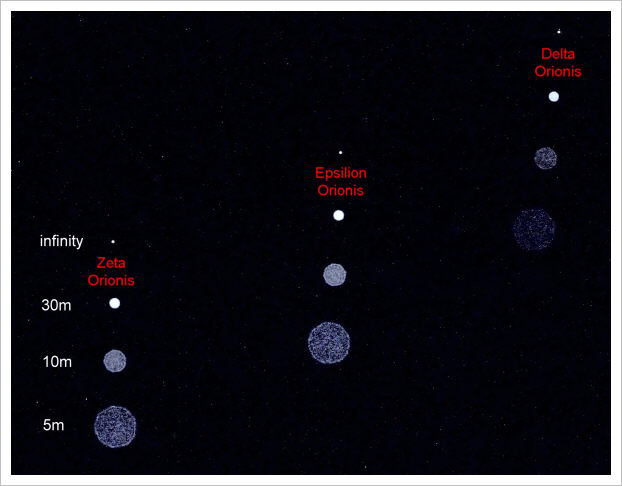

Focus Breathing (Focal length variation with focus distance)

Left: Close focus image taken with a lens that shows "Focus breathing"
Right: Same distance, same "nominal focal length" but no "Focus Breathing"
Focus Breathing - What is it?
"Focus breathing" is the name often given to the change of focal length (and hence angle of view and magnification) when the focus distance of a lens is changed. I'm really not sure why it has become called "focus breathing", but that's the term that's often used for this phenomenon.
Focus Breathing - Why should I care about it?
People usually care about it because they don't expect it. Lens manufacturers don't talk about it and most lens tests don't look for it, so when a user stumbles on it by accident or learns about it off the web, they are surprised and sometimes feel "cheated".
The typical thing someone will notice is that the image magnification they get with their 135mm prime lens is higher than that they get with their 70-200 zoom set to 135mm when shooting from the same distance. This prompts a question to an internet forum and they learn the hidden truth!
Probably the major effect will be reduced magnification at closest focus compared with a lens that doesn't "focus breath". However the maximum magnification is always given in the lens specifications, so it shouldn't be a surprise to the buyer.
Focus Breathing - Why should I not care about it
Because if it wasn't pointed out to you, you'd probably never notice it! If your 200mm lens turns out to be only 180mm when focused at a distance of 10m it really isn't a big deal. Sure, the image will be slightly lower in magnification than you expected (about 10%), but if you take a step closer to your subject, you'll get that magnification back. Only when you can't move closer or zoom out more does focus breathing become an issue.
Focus Breathing - Why does it happen?

Example of internal focus using a small element group
Because most current lenses use an internal focus system. That means instead of moving the whole lens barrel back and forth to focus, a small group of elements inside the lens are moved. The advantage of this is that the small group of lenses is smaller and lighter than the whole lens, so it can be moved faster with less power to give you faster AF. It's also possible to minimize aberration changes with focus distance by moving alements around. Of course if you move some of the elements around within the lens and leave others in place, you change the optical parameters of the lens. One of those parameters might well be the effective focal length (or angle of view if you prefer). The effect can vary from lens to lens, depending on the design.
Other truths about lenses you might not know
Lenses are rarely exactly as marked when it comes to focal length (or aperture, though that's another issue...), especially telephoto lenses. I looked back through some old copies of "Popular Photography" from the days when they published lens tests with actual focal length measurements. Their measurements were to the nearest 1/100mm, but I've rounded off the numbers. I haven't identified the actual lenses in the table below, just the manufacturer and the nominal maximum focal length in the case of zooms. These lenses weren't chosen for any reason other than they were the first ones I came to when flicking though my stack of old magazines!
| Manufacturer | Nominal Maximum Focal Length |
Measured Maximum Focal Length |
Difference |
| Vivitar | 500 | 479 | -4.2% |
| Nikon | 135 | 126 | -6.6% |
| Canon | 300 | 282 | -6% |
| Sigma | 400 | 386 | -3.5% |
| Tokina | 200 | 191 | -4.5% |
| Tamron | 300 | 286 | -4.7% |
| Minolta | 300 | 282 | -6% |
| Pentax | 200 | 189 | -5.5% |
| Avenge difference between "nominal" and measured focal length | -5.125% | ||
As you can see, it doesn't much matter who made the lens or what the maximum focal length was, in every case the measured maximum focal length is less than the marked maximum focal length, and the average difference is about 5%. The difference is always on the short side. I didn't find any examples where the actual focal length of a telephoto was longer than marked!
Focus Breathing - Let's get technical
How do you measure focus breathing...in fact how do you measure focal length - and what exactly is focal length?
Technically speaking, focal length is the distance from the rear nodal point (plane) of the lens to the focused image (plane) when an image at infinity is in focus. Thus focal length is defined using infinity focus.
Focal length and format size define the angle of view of the lens (and hence magnification). This applies at all focus distances. If you know the angle of view, you can calculate the focal length (infinity focus) or the effective focal length (closer than infinity focus). For more information on this see my article on Angle of View
You can use the relationship between angle of view and format size to determine focal length using a method I've previously described in article on Measuring Focal Length, which at this point you should probably go off and read. Basically the technique involves taking a shot of the night sky, then from the known angular distance between two stars and the measured distance between their images in the image, you can calculate the focal length of the lens (focused at infinity). Working carefully you can easily calculate focal length with an accuracy of better than about 0.1%, at least for telephoto lenses.
What I didn't cover in that article is that you can also use this technique to measure focus breathing. You do exactly the same measurements, but instead of focusing at infinity, you focus at 30m, 20m,10m, 5m etc. Yes, the star images will be out of focus, but if you stop the lens down the star images will still be quite visible. They'll just be small circles instead of points. The measurement doesn't care whether you are measuring the distance between points or the distance between the center of two circles, and the angular separation of the stars doesn't change of course.
The following is a composite image made up from 4 shots of the 3 stars of Orion's belt taken with a 70-200mm lens (set to 200mm) at focus distances of infinity, 30m, 10m and 5m

I think it's pretty clear that as the focus distance is decreased, the distance between the stars decreases. Since we know that their actual angular separation doesn't change. it must be the effective focal length of the lens (as expressed by its angle of view) that's decreasing.
If you run the numbers on this image, you find the following (rounding off to the nearest mm):
| Focus distance | Effective Focal Length | Horizontal Angle of View Full Frame |
| Infinity | 196mm | 10.5 degrees |
| 30m | 193mm | 10.7 degrees |
| 10m | 189mm | 10.9 degrees |
| 5m | 185mm | 11.1 degrees |
So that's "focus breathing" in a nutshell. If it bothers you, at least you now know how to measure it, but in practice it's rarely going to pose any problems. Even some of the best lenses do it. The Nikkor 70-200 F/2.8 VR II is known to be a "heavy breather". At closest focus (1.4m) reports are that the focal length (measured by magnification/angle of view) is around 135mm and at 5m it's around 175mm. This bothers some users, other's don't really care.
BTW if you want to retain a longer effective focal length (narrower angle of view) when close focused, you can use an extension tube. With an extension tube mounted you can focus down to close distances with the lens' focus set for close to infinity. You don't suffer the increase in the angle of view that you might by close focusing the lens so at a given distance from the subject you may get higher magnification. However you may increase some aberrations which the lens itself compensates for at close focus distances. Again, it all depends on the lens design. The only way to tell is to try it and see.
